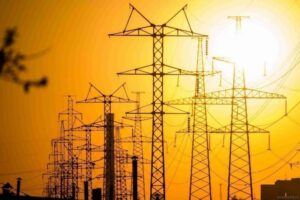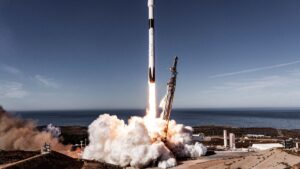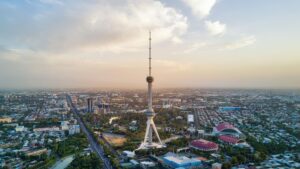
A combination of several factors: increased generation, reduced consumption due to the weekend and warm weather, as well as network repairs contributed to the absence of blackouts on Sunday, but Ukrainians still need to prepare for the application of power supply limitation schedules on weekdays, DTEK executive director Dmitry Sakharuk said.
“A combination of several factors allows today, on a particular day, not to limit consumption. But tomorrow, when it will be a working day and consumption will increase, schedules of cut-offs will be used,” Sakharuk said on the air of the National Telethon Unified News on Sunday.
At the same time, he explained that the increase of the generation and its supply was due to the return to the system of some thermal and nuclear units, the increase of the production of electricity by solar power plants due to the favorable weather conditions, as well as the networks repaired “thanks to the titanic work of energy specialists.
On the other hand, according to him, a positive role is played by warming, prolongation of the day and reduction of consumption due to the weekends.
At the same time Sakharuk specified that in addition to balance outages, that is, generation restrictions, there are also network restrictions, because of which in some areas there may still be outages.
“We still have a lot of places that were severely affected by the shelling and which have not been repaired completely, for example, Odessa, Kyiv region, Kharkiv region, Zaporizhia,” the DTEK top manager noted.
As it was reported, now all the nine nuclear power units available after the occupation of Zaporizhzhya NPP are in operation: over the last few days, the power system received additional 1220 MW of capacity after repair of one of the nuclear power units and 220 MW of additional capacity of another one due to the completion of repair of the turbine generator.

A Falcon 9 rocket on Sunday successfully injected another batch of 55 mini-satellites into orbit to replenish the orbital constellation of the Starlink global Internet coverage network, the developer SpaceX said.
“The launch of the 55 Starlink satellites has been confirmed,” the statement said.
The launch took place from the 40th launch pad of the U.S. Space Force Base at Cape Canaveral in Florida at 00:10 U.S. East Coast time (07:10 Kiev time).
About 1 hour and 4 minutes after the launch, the Starlink satellites separated from its second stage and entered a standard orbit.
This is the 73rd launch of a group of Internet satellites into orbit since May 2019 as part of the Starlink project and the fifth this year.
Including the current launch, SpaceX has already put more than 3,900 Starlink satellites into orbit. Some of them have malfunctioned or fallen out of orbit. Over 3.6 thousand devices remain in orbit in working condition.
Meanwhile, the first reusable stage rocket carrier rocket, which was used for the 12th time, about nine minutes after the launch made a vertical controlled landing on the sea platform drone A Shortfall of Gravitas, which was in the Atlantic at about 660 km from the launch pad.
In addition, a special rescue SpaceX vessel was to lift two fairing flaps of the rocket head part out of the water, which, after separation, descended by parachute. The re-use of the fairing saves SpaceX up to $6 million for its rocket launches.
The company is currently the largest satellite operator in the world. Internet from Starlink is available to users in 47 countries, including North America, Europe, the Far East and Australia. According to the Pentagon, the services of these satellites are also actively used by the U.S. military.
In the future SpaceX plans to deploy an orbital constellation of 12 thousand spacecraft (and in the future – from 30 thousand) to create a full-scale network, which will provide residents of the earth broadband Internet access anywhere in the world. The total amount of investments in implementation of the project is estimated at $10 billion.

Uzbekistan expects the inbound tourist flow into the country to grow by 34% in 2023, said Shukhrat Isakulov, advisor to the director of the UN World Tourism Organization (UNWTO) Silk Road office.
“If in 2016 2.2 million tourists visited Uzbekistan, in 2019 – 6.7 million. Of course, the pandemic has affected tourism, but since last year there is already a steady trend to increase the flow of tourists. Last year 5.2 million tourists visited Uzbekistan. This year, we plan to attract 7 million and exceed pre-pandemic indicators,” he told a press conference on Friday.

Authorities in Singapore have decided to abolish the requirement to present a certificate of vaccination against coronavirus or health insurance covering COVID 19 infection when entering the country, Asian media reported.
Such exemptions will take effect from February 13.
Mask wearing on public transport will be abolished but health care facilities will still require them.
Singapore’s Ministry of Health noted that about 80% of the population has received a minimum level of protection against the coronavirus through vaccination against COVID 19.
Last April, Singapore lifted much of the restrictions in place to combat the coronavirus.

6.9 million foreign tourists will visit India in 2022, four times more than in the last two years of the coronavirus pandemic, the Hindustan Times reported.
“Gangapuram Union Minister of Tourism and Culture Kishan Reddy said nearly 6.9 million foreign tourists visited India in 2022. After two years of decline due to the coronavirus pandemic, arrivals quadrupled. According to him, the increase in tourist arrivals means the industry is moving in the right direction to achieve sustainable tourism,” Reddy said.
Reddy said the Ministry of Tourism will emphasize inbound tourism this year and launch the “Visit India 2023” promotion. “We have 40 UNESCO heritage sites and we celebrate more than 1,000 festivals every year,” he specified.
He also noted that the country has built an extensive tourism infrastructure over the past eight years, and now the authorities want to rethink the approach to tourism in India.
“To ensure digitalization of the tourism sector, a ‘National Tourism Mission’ is being developed. In the first phase, the ministry has created a national integrated database of the hospitality industry, which should make it easier for businesses to operate,” the newspaper wrote.
Indian authorities also plan to develop adventure tourism, eco-tourism and other areas.

Ukraine may get at least five biomethane plants this year, the head of the Board of the Bioenergy Association of Ukraine (BAU) George Geletukha said.
“The topic of biomethane is developing very positively. Last year we managed to pass the basic bill (¹ 5464 from October 21, 2021). Also, the price of natural gas increased, and now it is more profitable to make biomethane than to let biogas for electricity. Companies are interested in this, and I think that this year we will see at least five biomethane projects,” Geletukha said at a press conference at Interfax-Ukraine on Friday.
He noted that the implementation of such number of projects during the war would be a positive signal and after the war Ukraine will be able to build up to a hundred of such plants per year.
Geletukha specified that already in the nearest February days the first plant with the capacity of 3 million cubic meters of biomethane a year will be launched in Chernihiv region by Hals-Argo company. In addition the company is also supposed to launch a project with a capacity of 10 million cubic meters in the Kiev region.
According to the BAU head, Hals-Argo has five operating biogas plants, which produce electricity, but it is more economical to produce biomethane.
Geletukha added that other companies are implementing three more projects expected this year with a capacity of 3 million cubic meters, 25 million cubic meters and 50 million cubic meters. One of the plants is built from scratch, four are converted to the production of electricity from biogas.
In addition the head of BAU said that today, in particular the European Bank for Reconstruction and Development is ready to consider credits for biomethane projects, in contrast to projects for the production of “green” electricity, as payments for it are unstable by the “Guaranteed Buyer”.
He explained that biomethane producers are not dependent on GarPoca and also have the potential to export it. However, Galetukha called the issue “still debatable.”
“There is now a ban on the export of natural gas, but biomethane is not. Therefore, the Ministry of Energy with regard to biomethane producers promises not to create any problems, but to bring its proposed batches (when they will be) into the quota, which is allowed for export. That is, promises to quota without restrictions,” said the head of the BAU.
At the same time, he noted that European companies are asking the association about the possible export of Ukrainian biomethane, but are waiting “and the first biomethane, and signals from the government, whether it can get to Europe.”
“It will be a positive precedent,” Geletukha summarized.
He added that Ukrainian businesses are more interested in exporting biomethane than selling it domestically, because in Europe they pay the so-called renewability premium, that is, for reducing greenhouse gas emissions.
“There is no such premium inside Ukraine, and it is quite interesting. Europeans are ready to pay it because of the tax on CO2 emissions in the amount of EUR80 per ton. Europeans are ready to buy more expensive biomethane in order not to pay this tax”, – described the situation Geletukha.
As reported, in July 2022 the Regional Gas Company and “Hals Agro” agricultural holding (the owner of LLC “Gorodische-Pustovarovskaya Agrarian Company”) have signed an agreement on connection of the biomethane plant in Chernihiv region to the gas distribution network. Then it was reported that at the beginning of 2023, Ukraine’s first physical connection of the plant’s capacities to the gas distribution networks was being prepared. Apart from the Chernihiv project, WGC announced the second biomethane plant in Vinnytsia region to be connected to the gas distribution networks in the second half of 2023.
In October 2022, RGC, Hals Agro and STX Commodities B.V. of the Netherlands signed a memorandum of cooperation to sell Ukraine’s first biomethane to Europe.
“We are gradually developing our project and are now entering the final stage – planning the sale of biomethane to the EU, which will allow us to work steadily and plan to expand production volumes,” said Hals-Agro director Sergei Kravchuk at the time.
Dionis Biogas Energy LLC (Dionis BGE, Kiev), which launched a new biogas complex with installed capacity of 4.5 MW in mid-February 2022, also announced its interest in biomethane.